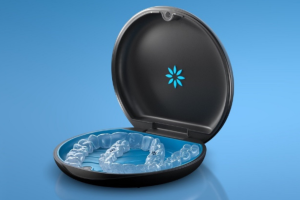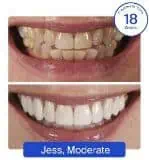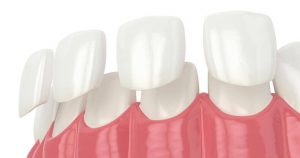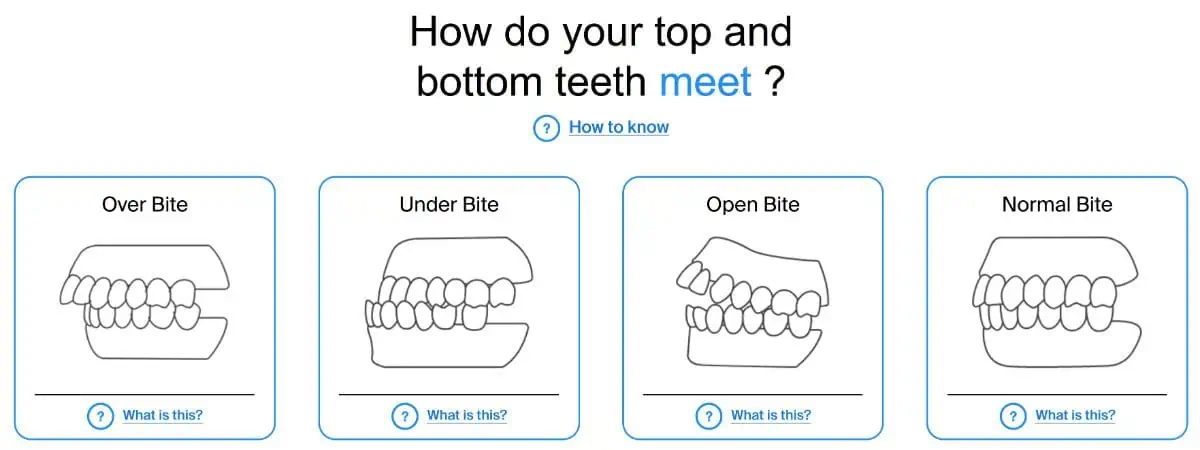There are a lot of treatment routes to a straighter smile to consider. But if you’ve narrowed it down to Invisalign vs veneers you may need help deciding between them. The Invisalign system and dental veneers are completely different approaches to improving your smile.
This article will break down each method, discuss the pros and cons of each dental treatment, and answer the following questions:
- Should you get Invisalign or veneers?
- What is the difference between these treatments?
- Who is a good candidate for each option?
- What does each treatment cost?
- Can you get veneers after Invisalign treatment?
The success of treatment depends on how suitable it is for your individual circumstances. We aim to give you all the information you need to help you make an informed and confident decision about your dental care.
Ultimately, your dentist or orthodontist will be able to recommend the best treatment for you, but it’s good to know all available options.
Invisalign and Veneers are entirely different dental procedures. With Invisalign, your natural smile will be straightened and aligned. Dental veneers are a quick way to make your teeth look better if they are slightly crooked, stained, or chipped. It’s best to speak to your dentist or an Invisalign provider.
If your dental issues can be corrected with Aligners, you might also want to consider the more affordable Invisalign alternative, Smile White. Like Invisalign they can solve 90% of teeth misalignment issues. However, they are up to 40% cheaper than Invisalign, and you’ll get free whitening and retainers worth £790.
Read our Smile White Review for more information, do the smile assessment, or book a FREE e-consultation.
Use code “DENTALY5OFF” to get an additional 5% discount on your treatment.
Whats the difference between the Invisalign system and veneers?

The Invisalign system and dental veneers are both viable options for getting a straighter smile, but which one is right for you?
As mentioned above, they are both completely different treatments and your circumstances will dictate which one is best for you. So, let’s get in into how they are different and which one is most suitable for you.
The Invisalign system
Invisalign aligners work just like invisible braces to straighten your natural teeth and align your bite. Treatment can help to resolve any orthodontic issues you may have rather than just as an aesthetic option.
The Invisalign system is a series of removable custom-made clear plastic aligners. These aligners apply pressure to your teeth to gradually straighten and align your smile. There is a range of options that treat anywhere from mild orthodontic cases to some complex cases.
Treatment may take anywhere from 3 months to 18 months depending on the complexity of your case and the number of aligners you need. Once your treatment is complete you will need to maintain your smile by wearing a Vivera retainer.

- Treats up to 90% of Cases
- Up to 40% cheaper than Invisalign
- Buy now, pay later in interest-free instalments
- Rated 4.9/5 on Trustpilot
- As seen on 5, BBC, 4, DailyExpress, TheMail
- Get 5% OFF with our discount code DENTALY5OFF and FREE Whitening and Retainers worth £790
Dental veneers
Veneers, on the other hand, are mostly an aesthetic option. They cover up your natural teeth making them appear straighter, better shaped and whiter.
They do not treat any orthodontic issues that you may have, rather they cover up chipped or crooked teeth, fill gaps and improve the overall appearance of your teeth.

Porcelain veneers are thin shells that are fixed over your natural teeth. They generally require some enamel to be shaved from natural teeth so the veneers don’t appear bulky when they are placed over your teeth.
The treatment time is relatively quick and depends on the type of veneers. Composite veneers can be done straight away if you have no underlying dental issues that need to be treated. Porcelain veneers take longer because they need to be made in a lab which can take between two and four weeks.
It’s important to remember that veneers don’t last forever, and eventually, you may need to have them replaced.
When it comes to eligibility you may find you’re not a candidate, and in some cases, you may need other dental treatments before you can get veneers.
Your dentist may even suggest that you need orthodontic treatment like the Invisalign system first. It’s best to make an appointment with your dentist to find out if you are a good candidate.
The following video summarises the differences between Invisalign vs veneers:
Let’s take a closer look at eligibility for each treatment.
Should you get Invisalign or veneers?

Your budget can influence your decision on which treatment to choose and your expectations also play a part. First, consider is which treatment you’re eligible for, as you may not be a candidate for one of the treatments.
Who is eligible for Invisalign aligners?
The Invisalign system can treat a range of different orthodontic issues from mild to complex. These aligners are suitable for anyone wanting to straighten their teeth and align their bite. Here are some of the orthodontic issues that the Invisalign system can treat:
- Gaps between teeth (diastema)
- Crooked teeth
- Overcrowding
- Underbites
- Crossbites
- Overbites
- Overjets
If you have severe malocclusion your Invisalign doctor may suggest traditional braces. However, with the continual advancements in Invisalign technology, the system can treat more and more cases.
If you want to find out if you are a candidate, take Invisalign’s Smile Assessment or book an appointment with your nearest provider to learn more.
Who is a suitable candidate for dental veneers?
Dental veneers are suitable for anyone with only mildly crooked teeth or stained, chipped or un-shapely teeth. Veneers can also cover up gaps and protect teeth with weak enamel.
Those with cases of malocclusion or with underlying dental issues such as gum disease are not ideal candidates for veneers. Dental veneers are not completely out of the question at this point; it just means that dental work is needed before the veneers can be placed.
This may include orthodontic treatment like Invisalign aligners which can take anywhere from 3 to 18 months to straighten and align your smile before veneers can be placed.

What are the pros and cons of each treatment?
Now that you have a better idea of which treatment you may be a suitable candidate for, let’s take a look at the pros and cons of each.

Pros and cons of Invisalign aligners
The main advantage of getting Invisalign treatment is that they are an efficient way to resolve any orthodontic issues while getting a straighter smile. The final result can last indefinitely if you wear your retainer as recommended, and maintain your oral health.
Your smile will look naturally straight at the end of your treatment. You also won’t need to worry about damage or discolouration of your veneers or unnatural looking teeth.
One of the disadvantages of Invisalign aligners is that treatment can take quite a long time. This means that Invisalign treatment is not ideal for those wanting instant results. They are also not a solution for chipped or stained teeth and you must adhere to wearing your aligners or your treatment will not work.
Wearing your aligners can cause discomfort and even pain at times. It can also take a little time to get used to them.
Pros and cons of veneers
The main advantage of dental veneers is that they are a quick route to a better-looking smile. They can cover up staining and chipped teeth, and make your teeth appear better shaped and whiter.
If you only have very mild orthodontic issues they can improve the appearance of teeth and smile in a relatively short time depending on the type of veneers you go for.
The disadvantages of veneers include the fact that they only last for about 15 years until you need to replace them. In most cases, you need to shave your enamel down to make room for the veneers so the procedure is irreversible.
Other disadvantages are that veneers are often different to your natural teeth and can become chipped or cracked over time.
What is the cost of veneers vs Invisalign aligners?
The cost of any dental procedure ranges between dentists and from practice to practice. However, in general, the Invisalign system may work out less expensive than the overall cost of veneers.
The cost of veneers can range from £100 per tooth to £1,000 per tooth depending on the type of veneers you get. The number of veneers you want or need also influences the price.
Invisalign treatment costs range from £3,500 – £5,500 depending on which option you need for your individual orthodontic case.
Summary of Invisalign vs veneers
There are a lot of differences between Invisalign treatment and dental veneers. Deciding between the two treatments can be hard, so we’ve summarised the differences between Invisalign vs veneers below:
Porcelain Veneers | Composite Veneers | Invisalign aligners | |
Practice Visits | Multiple | Usually just 1 | Multiple |
Treatment length | 2 - 4 weeks | Same day | 3 - 18 months |
Longevity | 10 - 15 years | 4 - 8 years | Indefinitely if a retainer is worn & oral health is maintained |
Aesthetics |
|
|
|
Cost | £400 - £1,000 per tooth | £100 - £400 per tooth | £3,500 - £5,500 |
Damage to existing teeth | Filing & enamel removal required except for Lumineers | Possible filing & enamel removal | No damage & orthodontic issues can be resolved |
Conclusion
If you are still debating whether you should straighten your smile with veneers or Invisalign aligners, it’s best to speak to your dentist or an Invisalign provider.
However, they are completely different procedures and in most cases, it should be easy to decide which one you will benefit from the most.
Invisalign aligners straighten and align your natural smile. This will help to resolve any orthodontic issues including some complex cases of malocclusion. Dental veneers are a quick cosmetic solution for very mild orthodontic issues, such as crooked, stained or chipped teeth.
You may not be eligible for either, and in that case, your dentist will advise on the treatment you need. If you think that you may need orthodontic treatment rather than a quick cosmetic fix, speak to your nearest Invisalign provider to find out more.
FAQs
Is it safe to get Invisalign treatment with veneers?
Yes, you can get Invisalign treatment with veneers as the veneers will not prevent your Invisalign aligners from applying pressure and moving your teeth into the desired position.
However, be aware that if your veneers are not fixed securely and are unhealthy then there is a small possibility they could get damaged in the process.
Can you get veneers after Invisalign treatment?
Yes, you can get veneers after Invisalign treatment. If you want veneers and Invisalign treatment your dentist will suggest you straighten your smile with Invisalign aligners first.
NCBI. Efficient Design of a Clear Aligner Attachment to Induce Bodily Tooth Movement in Orthodontic Treatment Using Finite Element Analysis. Consulted 28rd February 2022.
Prices stated are indicative only and are based on publicised treatment prices at dental clinics across the UK.




